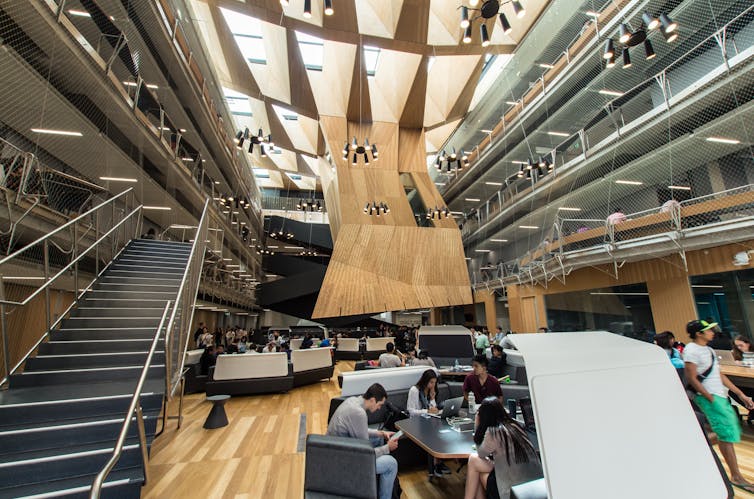By Gwilym Croucher, The University of Melbourne and Christopher Ziguras, The University of Melbourne
This week, Education Minister Jason Clare made an announcement that could reshape the landscape of international education in Australia.
He revealed how from 2025, Australian universities, TAFEs and vocational colleges will have caps on the number of international students they can enrol.
The approach is highly complicated. It involves some groups of students and excludes others, and uses formulas that apply differently to different institutions.
It will take some time for each institution to understand what this means for them and for sector-wide effects to kick in. Many details are also not yet public.
However, it is already clear Australia has taken a highly bureaucratic approach.
Our comparison with similar recent moves in the United Kingdom and Canada suggests it could set a new benchmark in government micromanagement of international education.
International parallels
For decades, Australia, the UK and Canada sought to attract international students. This included national branding campaigns and visa conditions allowing graduates post-study work rights. It also involved migration rules favouring graduates with certain types of skills.
Until recently, all three countries managed international education in two main ways. First, through quality assurance systems focused on the education international students receive. Second, through visa systems focusing on which students can enter the country, how much they can work and how long they can stay.
This approach worked well, with each country experiencing significant growth in international student numbers. In Australia, the number of international students has grown on average around 5% per year since 2005.
But when international student numbers grew very quickly after borders reopened post-pandemic, all three governments became concerned. They sought new ways to manage the influx of new students.
While many within the education sector argued the surge in new students was a short-term feature of post-COVID recovery, it proved very easy for others to portray the situation as immigration “out of control”.

What happened in Canada?
After the pandemic, the number of international students in Canada grew by around 30% per year for two years in a row. By 2023 there were more than one million international students in the country, compared with around 600,000 two years earlier.
In response, the Canadian government announced it would cap the number of study permits, to reduce the number of new international students in vocational and undergraduate programs by 35% in 2024.
Each province and territory has been given a cap based on its overall population. This will have a significant impact on urban metropolitan areas where international students prefer to study, notably the Greater Toronto Area, but will have less effect on other regions.
What about the UK?
The number of international students in the UK has also surged, reaching a historic high last year of more than 750,000. This growth was entirely driven by an increase in students from non-European Union countries, as the number of students coming from the EU declined by 8%.
In response, the UK government stopped allowing international students to bring their partners and children with them.
This has already had an impact, with a 16% decline in student visa applications in the year to July 2024.

What’s going on in Australia?
Initially, through the now-infamous Ministerial Direction 107 (signed in December 2023), the Australian government tried to reduce the surge in new students by denying large numbers of student visa applications.
The Department of Home Affairs’ approach disproportionately affected students from India and low-income countries, while having little impact on students from China. The approach also disproportionately hit universities outside big cities and those with fewer international students.
Unfortunately, this completely undermined the Department of Education’s long-term strategy, which has been focused on increasing the diversity of the student population and the diversity of providers.
A new approach in Australia
So now the Albanese government is trying again. This time, each institution will be allocated a quota of new international students for 2025.
Australia’s largest universities, which also have high proportions of international students and are the most research-focused, will see the biggest cuts.
Many of these will have caps on new students set halfway between their 2019 and 2023 commencing numbers. Universities with the smallest proportions of international students will have their caps set at 2023 numbers. Private tertiary providers look like they will have significant cuts too.
The overall result will mean international students will find it more difficult to study at the large and high-ranked universities in Sydney and Melbourne. There will also be far fewer places in private colleges for lower-cost vocational programs.
The winners are public universities and TAFEs that currently enrol fewer international students.
What now?
What happens beyond 2025 is anyone’s guess, and will be determined through negotiations between the yet-to-be-established Australian Tertiary Education Commission and each provider.
What is clear is Australia is taking an even more extreme approach to managing international student enrolments than two of our major competitors.
Gwilym Croucher, Associate Professor, Melbourne Centre for the Study of Higher Education, The University of Melbourne and Christopher Ziguras, Director, Centre for the Study of Higher Education, The University of Melbourne
This article is republished from The Conversation under a Creative Commons license. Read the original article.
Looking to apply for an Australian visa or explore migration opportunities? We can connect you with a trusted Registered Migration Agent who specializes in student, skilled worker, partner, family, and visitor visas. Whether you're planning to study, work, or settle in Australia, they’ll guide you through every step of the process. Send your inquiries to themigrant.au@gmail.com, and we’ll help you get in touch with the right experts for your visa and migration needs!





